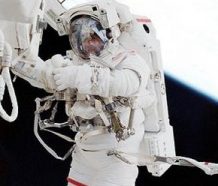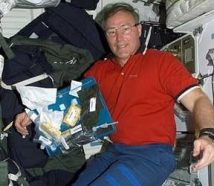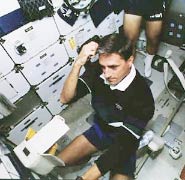Dreams of floating in space
Traveling into outer space is scary, fun, and a possibility for anyone who's willing to work hard enough to get there.
By Emily Sohn
On Feb. 1, just minutes before it was scheduled to land, the space shuttle Columbia tore apart, killing all seven of its crew. Early on, engineers suspected that the impact of a chunk of insulating foam, which had come loose from the main fuel tank during liftoff, had damaged the shuttle’s left wing, leading to the disaster.
Last month, accident investigators confirmed that falling foam had caused the tragedy. However, their final report also blamed poor management. The people in charge at the National Aeronautics and Space Administration (NASA) didn’t pay enough attention to safety. They had failed to recognize the dangers posed by falling foam even before Columbia took off.
Now, some people are wondering whether it’s worth continuing to send humans into space. It might be better just to put unmanned satellites into orbit and send robotic spacecraft on missions to other planets.
Astronauts have a different view. Traveling into outer space is scary, fun, and a possibility for anyone who’s willing to work hard enough to get there. Those were some of the messages from a panel of five astronauts at this year’s Intel International Science and Engineering Fair in Cleveland in May.
The Columbia space shuttle accident was a horrible tragedy, said Franklin Chang-Diaz, who has been to space seven times, including three space walks. But a certain amount of risk always comes with the exploration of new realms.
 |
|
Astronaut Franklin R. Chang-Diaz on a space walk.
|
| NASA |
“There is a carefully chosen price to opening any frontier,” Chang-Diaz told an audience of high school students. “We want to move beyond low Earth orbit to push open that frontier, like opening the West.”
For 2 hours, students lined up to ask questions, ranging from the practical (“How do astronauts go to the bathroom?”) to the philosophical (“How does your perspective on the universe change when you go to outer space?”).
Space dreams
Many of the astronauts’ answers focused on dreams. They encouraged audience members to pursue their dreams, even in the face of frightening challenges.
They also talked about some of their personal dreams. On the day before his sixth birthday, Donald Thomas watched Alan Shepard become the first American to go into space. “I thought, ‘I want to do that,'” Thomas said. “That has motivated me for my whole life.”
Thomas applied to NASA five times before he finally got the job. He has now been on four space missions, and he hopes for more.
Then, there are the space-y dreams. “I dream in three languages,” said Kathryn Sullivan, who was the first American woman to take a space walk. “English, French, and zero gravity. I still dream about that floating world.”
Zero gravity
All of the astronauts talked about how much fun it can be to float around in outer space. Astronauts experience weightlessness, or microgravity, because the spacecraft enters a state of freefall when it goes into orbit around Earth.
It’s the same effect you might feel on a freefall ride at an amusement park. If you let go a penny when you’re on the ride, the penny will look like it’s floating because it’s falling at the same rate that you are.
In the same way, everything in the space shuttle is falling at the same rate, as Earth’s gravity keeps the spacecraft in orbit. So, things seem to float.
 |
|
Astronaut Jerry L. Ross, along with a tray of food, floats aboard the space shuttle Atlantis in 2002.
|
| NASA |
To practice for space missions, astronauts train in an airplane nicknamed the “Vomit Comet.” The plane climbs straight up, then plummets. During freefall, everything inside the plane seems weightless, just like in space. In fact, the space scenes in the movie Apollo 13 were filmed in the “Vomit Comet.”
Microgravity might make you feel sick at first. Once you get used to it, though, space living can be a blast, the astronauts said. “I love how goldfish crackers swim in schools,” Sullivan said. “So do M&M’s.”
Chang-Diaz likes to leave his camera floating by the window so that he can come back every now and then to take more pictures. “On entry, the camera starts to drift,” he said. “It’s a bit of a letdown to leave an environment where you can float and fly like Peter Pan.”
Space living
Space living does have its challenges. Going to the bathroom, for example, can be disastrous if you don’t watch what you’re doing. “You have to be careful,” Sullivan said. “Your mistakes follow you around.”
Harrison “Jack” Schmitt was more graphic. “The primary challenge is to make sure your ‘number two’ stays in the bag,” said Schmitt, who was the lunar module pilot for Apollo 17, the last mission to the moon. “Otherwise it gets into the fan and goes into the circulation path of the spacecraft. You know the next line.”
 |
|
Astronaut Don Thomas combs his hair during a space shuttle mission.
|
| NASA |
There are other challenges. Astronauts spend lots of time together in close quarters, and they can’t just walk away if they disagree about something. The food can get dull. And if anything goes wrong in space, the results can be catastrophic.
“When people tell me they’re not afraid to go to space,” Thomas said, “I say: ‘Either you’re not telling the truth or you’re stupid.'”
Still, the perspective you get on life from outer space makes all the risk worthwhile, the astronauts said.
“When you are going around the planet every 90 minutes, you realize how small the planet is,” said Guion Bluford Jr., who was the first African-American in space. “You don’t see boundaries. Pollution doesn’t follow lines. We all share this rock together. This is home for all of us. We have to take care of each other and take care of this one place we call home.”
Just the fact that people have made it to space should fuel lifetimes of inspiration, Schmitt added. “Look at what humankind can do when we focus our attention,” he said. “If you believe it, anything is possible.”
At least some audience members left the session feeling inspired. On his way out of the auditorium, Jhanathan Bringas, a 16-year-old journalist from Lima, Peru, reflected on what he had heard. “If you have patience and want to do it,” he said, “we could really get to be what we want to be.”
That’s the kind of dream anyone can pursue, even here on Earth.
Going Deeper:







